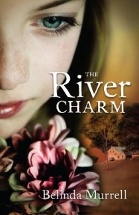The river charm by Belinda Murrell

Random House 2013. ISBN 9781742757124. pbk., 320pp., RRP $A15.95
(Age: 10-14) Historical fiction, written well, can provide a greater
insight into the life and times of a particular period better than
any website, textbook or other non-fiction resource. Historical
fiction, written well and woven around actual people, places and
events can bring the past to life and enable students to really
appreciate the contrasts between life in a particular timespan and
their own enabling them to reflect on not only the changes that have
occurred, but, often, why they have. Such is The river charm
by Belinda Murrell.
Based on the author's own family tree which includes Charlotte
Barton (Atkinson) the author of the first children's book to be
published in Australia A mother's offering to her children, by a
lady, long resident in New South Wales, this story tells of
the challenges facing Charlotte's family in the 1840s. Set initially
in the NSW Southern Highlands where many of the landmarks mentioned
still exist (the Hume Highway crosses the Medway Rivulet at the
Three Legs O'Man Bridge) Charlotte and her children live in a
glorious mansion wanting for nothing, presumably well-catered for by
the legacy of her first husband and the children's father. However,
being a single female, even a widowed one, was not acceptable in
those times and so Charlotte's destiny is in the hands of the
executors of James Atkinson's will. A series of events, disclosed
later in the story, leads her to marry local George Barton, a
mistake she lives to regret for the rest of her life.
Barton is a violent drunk determined to spend and drink his way
through his new-found riches, and so Charlotte gathers the children
and they flee in fear for their lives to a remote outstation (near
the Cambewarra Mountain). Life here allows the reader to appreciate
the courage and resilience of those who settled such remote areas,
particularly women, such as being two days ride from a doctor who
decides the cure for Louisa's croup is to bleed her using leeches,
giving her a potion which makes her vomit and then rubbing caustic
soda on her neck so that it burns and blisters the skin!
Circumstances take them to Sydney to live, but too poor to live in
town, they rent a cottage in a nearby fishing village called Double
Bay. However, worse than being a single female, is being a married
one who chooses to leave her husband despite his being known as an
angry drunkard, and so their situation worsens and Charlotte
continues to be involved in a battle with the executors, the lawyers
and courts. It is an intriguing tale that will enable the reader to
appreciate the journey that women have travelled and endured.
Told to Charlotte's modern-day descendants by Aunt Jessamine with
whom they are holidaying, and seamlessly slipping between the
generation gap drawn together by a pebble from a river on a charm
bracelet, this is a title that should be on the library's shelves.
Even though the key character is Charlotte's eldest daughter, also
Charlotte, we are introduced to Louisa,
the youngest, who went on to become a leading naturalist of her
time, evidence of her mother's belief that education was as critical
for girls as boys and her total commitment to this.
This book would make a valuable resource to support the History
strand of the Australian National Curriculum (there are teachers'
notes ) but above all, it is just a strong, engaging read
written with the sensitivity and respect that characterise the
author's works.
Barbara Braxton